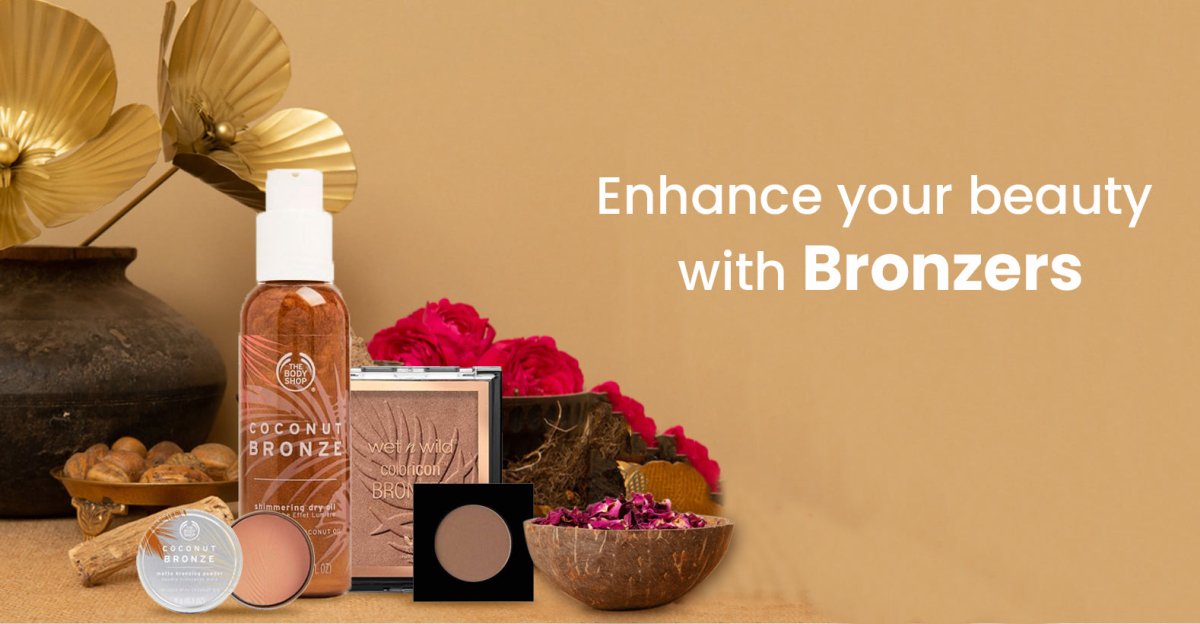Things You Should Know About Bronzers:
Today in 2021, there are so many makeup products on the market that it is impossible to keep track of them all. In addition, you see new makeup products techniques emerge every now and then, necessitating a refresh of our cosmetic wardrobes. Many of you wonder what all the fuss is about with bronzing and why there is so much hype. The aim of a bronzer used to be to add some sparkle to your face, but that is no longer the case. Bronzer is a makeup must-have that is put to the face, neck, and skin to get an image to appear. Bronzers really provide skin types with a natural daylight glow while also contouring blemishes, acne, and other imperfections. When you use a bronzer, it changes your skin's colour, making it look bronzed and glistening. Even if everyone understands the objective of a bronzer, they are hesitant to use it however they are unfamiliar with its purpose and application.
What is Bronzer?

Your skin is flat and lacks contour. Face Bronzers can be used to give it a more defined shape and change its skin colour. Bronzers can be used on any portion of the skin that is exposed to the sun, including the face, neck, hands, and legs. When you use it on your face, it appears slimmer and more structured, with better contours. Bronzer adds a coating of colour and sparkle to your complexion while also highlighting your cheekbones. Bronzer item is one of the best makeup products, which are an extremely soft powder that comprises golden light-reflecting particles or bronzing ingredients, which take away the highlighter's function. This adds a shimmering touch to the skin texture and removes the risk of the face looking muddy after face makeup. A bronzer's products benefits can only be seen and felt on your skin if you know how to apply it perfectly. Your skin will seem orange-coloured or unclean if you apply the bronzer incorrectly.
Ingredients of Bronzers:
- Talc
- Titanium Dioxide
- Isostearyl Neopentanoate
- Polybutylene Terephthalate
- Magnesium Stearate
- Acrylates Copolymer
- Phenyl Trimethicone
- Polybutene
- Aluminum Hydroxide
- Stearic Acid
- Methylparaben
- Ethylene/va Copolymer
- Tocopheryl Acetate
- Propylparaben
- Tocopheryl Acetate
- Prop ParaffinumLiquidum mineral Oil
- Parfum/fragrance
- CocosNucifera Coconut Oil
- ParaffinumLiquidum Mineral Oil
- CocosNucifera (Coconut) Oil
- CocosNucifera (Coconut) Oil ButylphenylMethylpropional
- Benzyl Salicylate, Citronellol
- Hexyl Cinnamal
- Hydroxyisohexyl 3-cyclohexene Carboxaldehyde
- Linalool
- Aloe Barbadensis Leaf Extract
Benefits of Bronzers:
A bronzer can be used to conceal flaws such as a broad nose. Test it on a tiny section of your face first to see if it will seem natural when used all over. Just apply bronzer to both sides of the nose with a powder brush. To balance it out, brush more on your cheekbones and forehead. Then blend the bronzer with your foundation or powder. The use of a slight shadow should provide the appearance of a thinner nose.
Coverage is Sheer:

These formulae have very light coverage, and it is a good thing, too. Because you are simply trying to create the impression of a tan, the sheer coverage lets you regulate the colour and pigment. The light tint is suitable for most skin types, while individuals with oily skin should use a powder rather.
Layer Away:
The formulas are buildable and provide a lovely layering effect. Do you want to add some depth to your styling? On top of that, apply your powder bronzer. It is another method to provide depth to the tan without using a tone of powder. Furthermore, the creams reflect light, giving you a dewy, natural-looking bronze.
Add Shimmer:
It must appear natural. The way the sun casts a beautiful glow on your face and neck. Stick to a satin, shimmer-free finish because the sun doesn't drop fairy dust on you.
Don't Use Them All Over Your Face:
Bronzer should be applied to cavities of your cheeks, under your jawline, along the bridge of your nose, and to outline your face. When you apply bronzer all over your face, it can make your features look dusty and flat. Use it to draw attention to your features and create a difference with your natural skin tone.
How is it Different From Contouring?
Although both bronzers and contours are used to define and darken specific parts of the face, they are not the same. Using a cool-toned matte cream or powder, contouring creates shadows on the face. The cheekbones, jawline, forehead, and nose are all defined by this feature. Bronzing can also add definition to the face, although it is generally used to add warmth and brightness to the face by using a warmer toned product. There are different types of best Bronzers that come in various formulations and can be matte or shimmery.
Types of Bronzers:
Bronzers are another beauty item like foundation that is come in a variety of colours and textures. Without getting too confused, here is a quick guide to help you choose the best bronzer for you. The skin's colour, tone, and texture after makeup will be determined by the bronzer you choose. Bronzers come in various forms, including pressed powder, cream bronzer, loose powder bronzer, and liquid bronzer.
- Dry skin is more suited to pressed powder bronzer than an average or oily complexion.
- Cream bronzers are suitable for dry-skinned women, and cream bronzers contain hydrating properties. For oily or acne-prone skin, loose powder bronzers are ideal.
- Finally, liquid bronzers are the most popular among all forms of bronzers due to their ease of application. Liquid bronzers come in a container or squeeze tube and can give the face a dewy appearance.
Which Bronzer to Purchase?
Based on Undertones:
Undertones also influence your bronzer type, and golden brown bronzers are best for warm undertones. If you have cool undertones, stick to neutral colours.
Based on Climate and weather:
The weather and environmental conditions have a part in determining which bronzer you will need to purchase. While matte bronzers are preferred in the summer, sparkly bronzers are preferable in the winter.
Based on Skin Complexions:
Choose a face bronzer with a golden undertone if you have a fair skin tone. Choose a rose bronzer if you have a medium skin tone. Pure red undertones are ideal for a dark-skinned complexion.
How to Select the Right Bronzer:
To brighten up your face and make you look more alert, invest in two tones of bronzer that is somewhat darker than your natural skin tone but still works on your neck and a brighter shade with a pinkier or peachier tone. Choose a bronzer colour that matches your undertone for the most natural effect. Undertones are divided into three categories: warm, cold, and neutral, and each of them includes tones inside it, regardless of how light or dark your skin is.

How Does it Work?
Bronzers contain an active component called DHA, which gives a golden glow rather than an unnatural orange-burnt appearance. Lotions and creams now contain self-tanning chemicals thanks to DHA technology. DHA is found in 4-5 percent of self-tanners and 2-3 percent of bronzers. Like any other makeup, a bronzer is a quick fix that can last up to a week, similar to self-tanners, depending on the manufacturer. It normally dries quickly, and the natural-looking tan takes approximately an hour to emerge. Cosmetic bronzers, for example, were once wiped away with soap and water.
How to Use:
- The skin should be free of impurities and dry.
- Remove any and all jewellery.
- To protect your skin and scalp from stains, wear a shower cap.
Rotate the product onto the skin. Avoid sensitive areas such as the eyes, eyelids, and the area around the lips. Consider the changes in your skin colour when applying different amounts of bronzer. If your face colour is lighter than your arms, for instance, you should apply fewer makeups on it.
Try to know where the sun frequently strikes your face to obtain a sun-kissed bronzer makeup look. It strongly impacts the cheekbones, nose, chin, collarbones, and a muted impact on the forehead. Bronzers may disguise blemishes, but they can highlight wrinkles, so be gentle with those wrinkles.
Brush through all regions of the body, particularly the ankles, in between the toes, ankles, and knees. If you neglect some parts, your tan will appear artificial. Unlike cosmetic bronzers, most bronzers now do not discolour clothing. After you have gotten used to the colour, you can move on to a darker tint. Just make sure it is still natural-looking.













